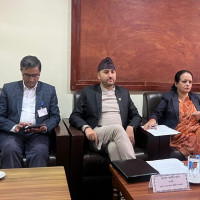- Tuesday, 16 December 2025
Nepal Struggles With Cooking Transition
Access to clean cooking is essential to economic development and achieving sustainable development goals. As of 2023, 2.3 billion people worldwide remain without access to clean cooking, and over 3 million people die from household air pollution (HAP), mainly due to particulate matter and toxic compounds such as black carbon, volatile organic compounds, and polycyclic aromatic hydrocarbons emitted during solid biomass and fossil fuel combustion. Approximately 51 per cent of households in the country rely on solid biomass cooking. The combustion of solid biomass for cooking is responsible for over 24,000 premature deaths annually, which is a truly alarming number. Through its second nationally determined contribution, the government has set an ambitious target of providing electric cooking access to 25 per cent of households by 2030. However, the over-reliance on fossil fuels is one of the main hindrances to the country’s goal of achieving 25 per cent electric cooking by 2030. 94 per cent of Nepal's population has access to electricity, but only 0.5 per cent of the households use electric cooking, as the Water and Energy Commission Secretariat reported in 2023. Unreliable electricity, household-approved electric load capacity, wiring issues, lack of consumer awareness, and affordability have hindered the wide adoption of electric cooking.
As per the report of the National Statistical Office, the import of electric cooking appliances decreased to 1.4 million in 2022/2023 from 1.6 million in 2021/2022, whereas on the other hand, the import of liquid petroleum gas (LPG) increased from 477,752 MT to 536,028 MT, which is a 12 per cent growth. This import has caused the Nepal Oil Corporation to lose nearly $300 million annually because they sell it at a subsidised rate. The government of Nepal intends to reduce LPG use and increase the use of electrical appliances. It has also announced the transfer of the LPG subsidy towards electricity to promote electric cooking, but there has not been any noticeable progress.
Efficient cookstove adoption
Out of 51 per cent of solid biomass cooking, most households use traditional mud cookstoves, with a lower thermal efficiency of only 10 to 15 per cent. This means that much energy is wasted during cooking, resulting in more firewood consumption and, consequently, higher indoor pollution. The Nepal Interim Benchmark for Solid Biomass Cookstoves (NIBC) has been responsible for certifying stoves in terms of efficiency, emissions, safety, and durability. Though various cookstoves distributed to communities were deemed NIBC-certified, their usage seemed rare in households. The initial acceptance of distributed stoves was quite encouraging, but there is a sharp decline of over 80 per cent in their usage over time. One of the major reasons for the declining rate of sustained use of these cookstoves is inappropriate design and unmet requirements of the users. Since the sustained use of cookstoves is ultimately determined by the preference of the cookstove users.
An important aspect of technical and social requirements, including appropriate stove size, design, and user engagement prioritisation, was missing in our clean cooking programme. The design process of cookstoves must involve users, specifically women, and focus on designing participatory approaches to the clean cooking programme. For instance, some of the improved cookstoves cannot handle the sizes of wood that the traditional mud stove could easily handle, which is one of the reasons why users prefer traditional cookstoves over improved ones. Similarly, the small size of the improved cookstove is another prominent reason for discarding it without use.
A review article titled "Is Clean Cooking Affordable? A review published by the Energy and Research Group of the University of California, Berkeley, in 2021 found that only one biomass stove (Mini Moto) currently meets WHO standards (i.e., tier 4 for thermal efficiency and emission rating). The WHO guidelines for indoor air quality recommend that only tier 4 stoves can mitigate the burden of disease associated with HAP. There are no biomass cookstoves in Nepal that can meet tier 4 standards for thermal efficiency and emissions. This indicates that, despite advancements in cookstove technology, improved cookstoves distributed in Nepal still pose severe health risks, particularly affecting women and children.
Survey reveals trends
The findings of a recent survey conducted by the research team at the Renewable and Sustainable Energy Laboratory at Kathmandu University revealed a surprising trend in the cooking practices of households in Kavre. Despite the region's reputation for tourism and its abundant access to modern facilities, the survey uncovered that many surveyed households still relied on traditional biomass stoves. In Kavre, it was found that out of 50 households surveyed, more than 35 households have received induction cookstoves as part of the clean cooking programme. Nevertheless, it was found that less than 10 of the households were using them, and some of the reasons for abandonment were inadequate know-how of operation, unreliable electricity, and low-quality products, and therefore, they gave it to their relatives. This pattern of disadoption of electric cooking technologies highlights serious challenges in the transition to clean cooking. It shows that distribution is not enough for the sustained use of technology.
Lastly, policies and targets alone do not ensure a clean cooking transition unless the policies are implemented and the targets are met. Evidence-based policy drafting and target setting increasingly ensure the narrowing down of the gaps between targets and implementation. To ensure evidence-based policy formulation and target setting, the government must collaborate with universities and support research and innovation. There is no other way to generate evidence than research and innovation. Evidence-based intervention is essential to drive the transition to clean cooking energy and achieve SDG 7 by 2030. Without evidence-based action, Nepal's vision of a clean cooking transition by 2030 remains unfulfilled.
(Dr. Lohani is a renewable energy professor, and Pandey is a research assistant at Kathmandu University.)
















